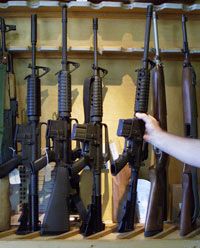Panic Room Features
Communication
It's a good idea to leave a cell phone or ham radio in your panic room in case you need to communicate with the outside world. But if your panic room is too isolated or reinforced for reliable cell phone service, you can always install a buried phone line, an intercom system or an alarm button directly connected to a police or security team.
You'll also want to keep your communication secret from intruders. Soundproofing the panic room prevents an intruder from hearing your conversations with law enforcement. And if the invaders do discover that you're in the room, they won't be able to taunt you verbally.
Advertisement
Surveillance
You might remember that Jodie Foster's panic room had a wall of monitors that dramatically displayed each corner of the house. The typical panic room -- if it does have surveillance -- has one monitor connected to a number of hidden cameras. High-end panic rooms can also utilize heat-sensing cameras, so if the home is attacked at night, you can covertly check out who's in the house.
Power
Most panic rooms are powered by generators. You have to be careful about ventilation, though, and always be mindful of carbon monoxide poisoning. Generators must be self-contained in the panic rooms, which necessitates more room -- and more money. In the most basic panic rooms, battery-powered or hand-cranked lights and phones may be sufficient.
Air circulation
The most elaborate and expensive panic rooms are airtight, temperature- and humidity-controlled chambers. They can have separate air-filtration systems that protect from biohazards, and dummy vents to throw off invaders. And as a last resort, high-end panic rooms can include oxygen masks.
Plumbing
Again, depending on how much you want to spend, plumbing can be as basic as a portable toilet -- or you can install separate plumbing and a septic tank. Of course, you'll want to stock the room with water (a gallon per person per day is a general guideline).
Supplies
This is where people can get a little crazy, depending on how much they're willing to spend. The supplies are what help the occupants survive an attack -- like food, water and first aid equipment.
Supplies for the über-wealthy can go way beyond the basics -- to keep the masters of the house preoccupied with thoughts other than who's stealing the good silverware, panic rooms can become luxurious dens with beds, wet bars and entertainment systems. Some owners even build two panic rooms: one for the parents and one for the kids. High-end panic rooms often include items like chemical washbasins -- to rinse off biohazards -- and gas masks.
Weapons
If you built your panic room to protect your family from hurricanes, stocking the room with weapons will probably not be a priority. But if you think you might have to defend your estate from armed terrorists, you'll probably want an arsenal. Pepper spray comes in on the low end, and the sky is pretty much the limit on the high end: You can arm each member of the household with a gun, for example, or install high-voltage stun devices under the carpet in case an intruder makes it into the room.
In the next section, we'll find out how you can get your own panic room.
